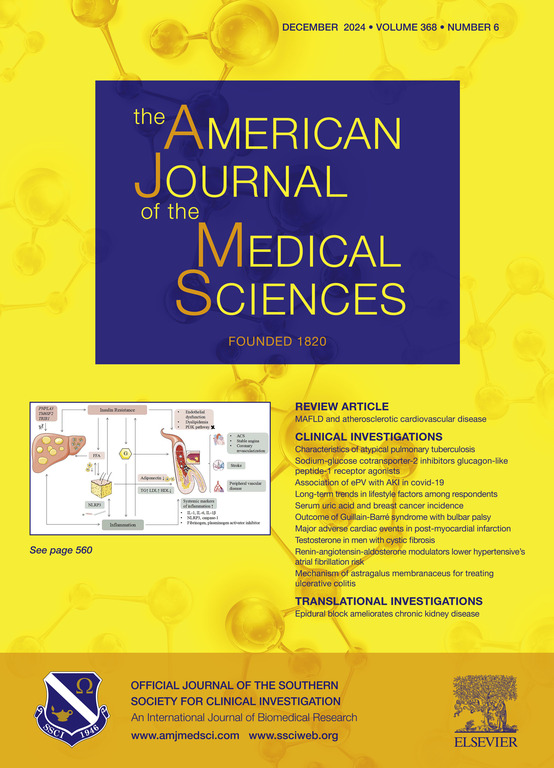Outcome of Guillain-Barré syndrome with bulbar palsy
IF 2.3
4区 医学
Q2 MEDICINE, GENERAL & INTERNAL
引用次数: 0
Abstract
Background
Elective intubation is advocated in Guillain-Barré syndrome (GBS) with bulbar palsy to prevent aspiration pneumonia and lung collapse. We evaluate the outcome of GBS patients with bulbar palsy, and also compare the risks and benefits of intubation and MV in them.
Methods
187 GBS patients with bulbar palsy from a cohort of 547 GBS registry were analyzed. Detailed clinical records and peak disability on a 0-6 GBS Disability Scale (GBSDS) were noted. The patients were intubated if arterial blood gas (ABG) analysis revealed hypoxia, hypercarbia or acidosis. The patients with normal ABG parameters were fed by nasogastric tube, and nursed in lateral position. Occurrence of pneumonia, in-hospital death and outcomes at 6-months were classified as complete (GBSDS <2), partial (GBSDS 2-3) and poor (GBSDS >3).
Results
76/187(40.6%) patients required MV, and they had a shorter duration of illness (p = 0.007), higher peak disability (p < 0.001), autonomic dysfunction (p < 0.001) and more frequently received IVIg (p = 0.02). Pneumonia (63% vs 10.8%; p < 0.001) and in-hospital deaths (7.9% vs 1.8%; p = 0.06) were more frequent in MV group compared to nasogastric fed group. At 6-months,104 (55.6%) patients recovered completely. On multivariate analysis, the independent predictors of poor outcome were peak disability [Adjusted Odds Ratio (AOR) 9.84, 95% Confidence Interval (CI) 3.15-30.74, p < 0.0001], day of hospitalization from disease onset (AOR 1.09, 95% Cl 1.01-1.01; p=0.009) and requirement of MV (AOR 0.10; 95% 0.02-0.50; p = 0.005).
Conclusion
GBS patients with bulbar palsy may be managed by nasogastric feeding and nursing in lateral position without increasing the risk of pneumonia. Mechanical ventilation based on ABG does not worsen outcomes of GBS with bulbar palsy.
格林-巴利综合征并发球麻痹的预后。
背景:对于伴有球麻痹的吉兰-巴雷综合征(GBS)患者,我们主张进行选择性插管,以预防吸入性肺炎和肺衰竭。我们评估了伴有球麻痹的 GBS 患者的预后,并比较了插管和 MV 对他们的风险和益处。方法:我们分析了 547 例 GBS 登记队列中 187 例伴有球麻痹的 GBS 患者。方法:对 547 例 GBS 登记队列中的 187 例 GBS 球麻痹患者进行分析,并记录了详细的临床记录和 0-6 级 GBS 残疾量表(GBSDS)的残疾峰值。如果动脉血气(ABG)分析显示缺氧、高碳酸血症或酸中毒,则对患者进行插管。ABG 参数正常的患者使用鼻胃管喂食,并采取侧卧位护理。结果显示,76/187(40.6%)例患者在住院6个月后发生肺炎、院内死亡,并在住院6个月后获得完全康复(GBSDS 3):76/187(40.6%)例患者需要使用 MV,他们的病程较短(p = 0.007),残疾峰值较高(p < 0.001),自主神经功能障碍(p < 0.001),更常接受静脉注射(p = 0.02)。与鼻饲组相比,中压组肺炎(63% vs 10.8%;p < 0.001)和院内死亡(7.9% vs 1.8%;p = 0.06)的发生率更高。6 个月后,104 名(55.6%)患者完全康复。多变量分析显示,不良预后的独立预测因素包括残疾高峰[调整比值比(AOR)9.84,95% 置信区间(CI)3.15-30.74,p < 0.0001]、发病后住院天数(AOR 1.09,95% Cl 1.01-1.01;p=0.009)和 MV 需求(AOR 0.10;95% 0.02-0.50;p = 0.005):结论:患有球麻痹的 GBS 患者可以通过鼻饲和侧卧位护理来控制病情,而不会增加肺炎风险。根据 ABG 进行机械通气不会恶化球麻痹 GBS 患者的预后。
本文章由计算机程序翻译,如有差异,请以英文原文为准。
求助全文
约1分钟内获得全文
求助全文
来源期刊
CiteScore
4.40
自引率
0.00%
发文量
303
审稿时长
1.5 months
期刊介绍:
The American Journal of The Medical Sciences (AJMS), founded in 1820, is the 2nd oldest medical journal in the United States. The AJMS is the official journal of the Southern Society for Clinical Investigation (SSCI). The SSCI is dedicated to the advancement of medical research and the exchange of knowledge, information and ideas. Its members are committed to mentoring future generations of medical investigators and promoting careers in academic medicine. The AJMS publishes, on a monthly basis, peer-reviewed articles in the field of internal medicine and its subspecialties, which include:
Original clinical and basic science investigations
Review articles
Online Images in the Medical Sciences
Special Features Include:
Patient-Centered Focused Reviews
History of Medicine
The Science of Medical Education.

 求助内容:
求助内容: 应助结果提醒方式:
应助结果提醒方式:


